Guide to Navigating the Workforce
How to lead your operations through today’s workforce challenges
Work as we know it has changed. Leaders are tasked with balancing the challenges of an increasingly demanding workforce with the general technological and digital transformation updates required to keep organizations operational — it’s no easy job.
Among day-to-day concerns, many leaders are thinking about:
- → How much will it cost to modernize operations?
- → How can we attract and retain new talent or appeal to a younger generation?
- → How will we replace retiring or soon-to-retire employees?
- → How can we upskill our existing workforce?
- → How can we grow business while protecting what we already have?
Labor shortages, outdated operations systems, and supply chain issues are forcing many COOs and CFOs to reevaluate “business as usual” and find technological solutions to deliver business to current times, all the while figuring out how it fits into an already strained budget.
But amid change, there is opportunity. During this time of flux, you have the perfect chance to implement technology and processes that will boost efficiency, attract talent and help your organization achieve sustainable growth in a time of uncertainty.
I. State of the labor market
As of recently, the COVID-19 pandemic has flipped the labor market upside down. After 2020 saw job losses reaching the highest levels since 1939, many workers responded by reskilling and making career changes. The labor market is now so in favor of employees that many quit their jobs before having their next opportunity lined up.
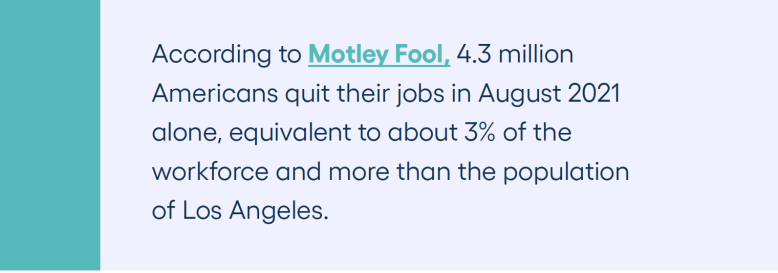
Though some workers are making changes ranging from seeking new companies to completely changing industries, there are many established employees with no intention of going anywhere. There are, however, two exciting groups for you to consider as you address your current labor concerns: new workers entering the workforce for the first time and retirees who have decided to return.
As younger employees begin their careers, you need to consider how technology has influenced nearly every aspect of their lives. From growing up with cloud-based, delivery-on-demand services like Amazon, GrubHub or Netflix to technology products from companies like Apple, today’s newest employees are so tech-savvy that it’s not only second nature, but an expected part of life.
While this can be helpful for organizations leveraging automation and AI to enhance productivity or operations, it can hurt businesses that have been slow to adopt technology. Without time-saving tools or tech that enhances collaboration or communication, you can expect younger employees (who have likely also not established a sense of loyalty) to seek employment elsewhere.
Another “new” group comprises older employees reentering the workforce after retirement. In this bracket, employees are returning for a myriad of reasons, ranging from boredom in retirement to an appreciation for newfound flexibility in some positions due to the pandemic. In some cases, these employees are simply returning to work to accommodate the rising costs of living.
So, what does that mean for employers? With an overwhelming shortage of qualified workers today, you need to support the needs of employees across the age spectrum. Because it’s challenging to recruit new talent while many highly-experienced employees are retiring in droves, it’s critical to create an environment where workers of all ages and skill levels can thrive together.
When it comes to the maintenance, facilities and operations field specifically, labor issues are magnified. For starters, you might have yet to fully invest in the technology to keep younger generations happy in their roles. And, if you do have tech in place, older employees can be slower to learn or adopt. To top it off, there is also a tremendous amount of historic knowledge kept by workers exiting the work world or hopping jobs.
In addition, the investment in the trades has dropped, leaving teams without many options for specialty skills for tasks like HVAC repair, leading to an increase in contract work, which can come with a hefty price tag.
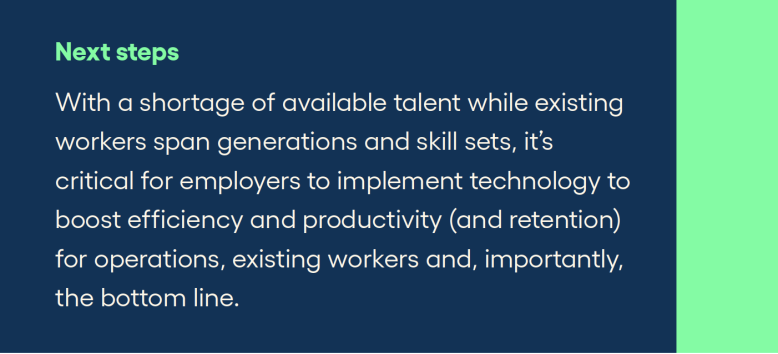
II. Creating opportunity within a diverse workforce
There are workers spanning four generations in today’s workforce, as well as more diversity across race, gender and other demographics than ever before. Employers face the tall task of navigating friction in the workplace, as you’d expect with any kind of community in which different backgrounds and perspectives are merging.
Sources of workplace friction Friction can manifest as a byproduct of:
- Different communication styles
- Different levels of career experience
- Different tenure
- Different comfort levels with technology
So how do you help your managers create a workplace where employees work well together regardless of differences?
1. Start with helping managers find common ground by focusing on what aligns their team across differences.
If two employees work in the same department for the same organization, they likely share an interest in the field. They might also have common goals or ideas for improving operational efficiency and team morale and want to provide good customer service.
At the end of the day, most people want to feel useful and do good work. Remind your managers of that and start there.
2. Create a learning-centric environment. No matter the age or background, everyone’s a student and a teacher.
One of the best things you can do to encourage growth for all employees is to foster an environment that celebrates learning. Each generation and group of people with a different perspective or approach can work for your business and lead to significant accomplishments.
Regardless of previous experience, everyone has knowledge to offer, and everyone has a gap in their education. Empower your managers to uncover where the strengths are on their team and encourage employees to take turns leading and learning based on their unique experiences.
3. Build mentorship into your workplace.
You don’t want all that legacy knowledge to walk out the door when an employee retires or leaves. Have your managers create a “we’re on the same side” environment for their teams through mentorship. Help managers work with, not against, other generations/groups to get everyone’s skills up to par rather than create more division.
When people feel understood and valued, morale improves and the doorway for communication opens. Look for where you can listen to better understand your managers; in turn, they will support their team members and help them instead of dismissing them.
Most employees want to feel valued and share a desire to be part of a winning team, which is important to remember if you’re observing sensitivity around the changing of the guards within departments. It’s understandable for employees to feel protective of their work and the way they’ve always done things, but you need to foster an inclusive environment for everyone to succeed. Creating a workplace that celebrates learning and mentorship can help employees of all generations feel appreciated and like they are contributing to something bigger.
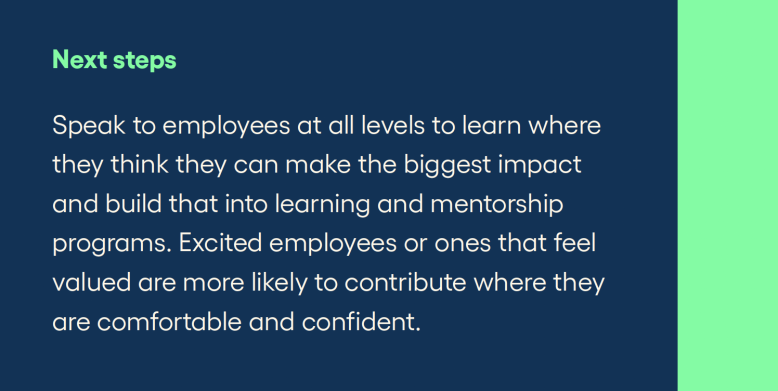
III. Training the workforce
No matter the age or background of your employees, they will need training – whether it’s technology, equipment fixes, or soft skills like communication. Use whatever resources you have at your disposal to help your managers, seek out training opportunities and reward those who participate however you can.
Training ideas for your employees
- → Promote internal learning courses already available
- → Look for apprenticeship/mentorship opportunities
- → Partner with local trade or technical schools for educational opportunities
- → See if your insurance provider will help with training (ex. for drivers)
- → Seek out free or inexpensive online technical training (ex. YouTube tutorials or Linkedin Learning)
- → Reward extra training with recognition or other benefits → Set quarterly development goals
Employers know: the skills needed for today’s operations professionals have changed, and many of those required skills are in shortage.
Rate of retirement, lack of trade skills, rise in the need for technology-based knowledge and a reduced labor market are combining to present quite the challenge for employers. If you want to succeed in bridging the current skills gap, it’s essential to find ways to develop your managers’ and their direct reports’ skills. Keeping the concept of agility in mind can help you remain flexible, open and optimistic about what comes next.
As you work to grow your workforce, remember that there are different types of skill sets needed.
Technical skills are critical to operations, but we know this can be a difficult gap to bridge. That is where adding mentorship, outside training opportunities and skill development can come in handy.
Soft skills are communication, collaboration, listening and critical thinking — and we can all get better at those. This is a great place to start with improvements that can help your entire organization. You might even uncover hidden leadership talent.
Digital skills will only grow in demand. Now is the time to develop your organization’s tech capabilities as much as possible. Today’s technology is generally easy to use and made for any age and skill level, so jumping in is the best way to get acclimated. (And bonus, software vendors can help your managers set up virtual training and more!).
Every employee can benefit from learning. Technology helps make skills training easy and accessible via online courses, a mobile app with communication training or a software system to log your daily work.
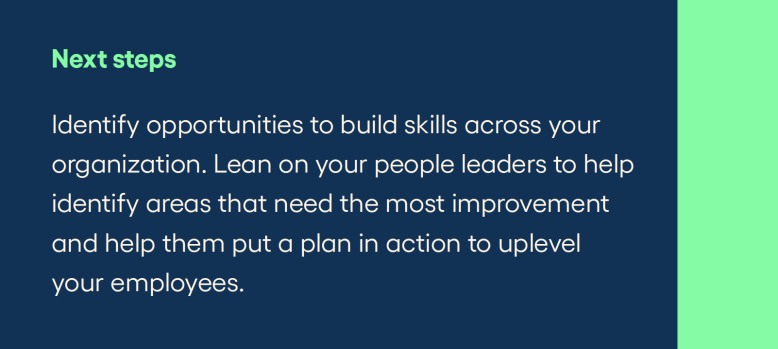
IV. Setting your organization up for success
As a leader, you’re charged with steering the ship into unknown waters through any condition — so you know how important it is to build procedures and policies to protect your crew and your cargo. While the tides change, documentation, analytics, and communications can help keep your boat afloat.
One of the easiest ways to ensure operations run smoothly is to prioritize documentation processes. Work with your managers to maintain adequate documentation. As things change with workers moving around in this challenging labor market, having a record of as many things as possible is critical. Make sure there is digital documentation for work orders, equipment and asset conditions, safety manuals, utility use, set-up and teardown tasks for events at your facility, and even daily tasks. This information can help managers save time getting new employees and contractors up to speed.
If you’re not already, track and analyze everything. Your managers need to know what work gets completed every day, but also what doesn’t. You can use a mobile CMMS (computerized maintenance management system) to track work and staff productivity and predict what resources you will require and when.
If you’re not tracking what’s happening across your operations, how can you know where the gaps are? With proof points and data, it’s easier to understand when to hire and what skill set to look for (or contract out) — and save time and guessing in the process.
Communicating frequently with employees is one of the most overlooked ways to help an organization during times of change. No one wants to be in the dark; regular communication with employees can let them know the why/when/how changes are happening, what they can do to stay up-to-speed and what resources are available. And it reinforces their sense of value, which is extra valuable regarding retention.
You don’t have to have all the answers, but documentation, tracking and communication are three pillars that can help you lead your organization in a time of uncertainty.
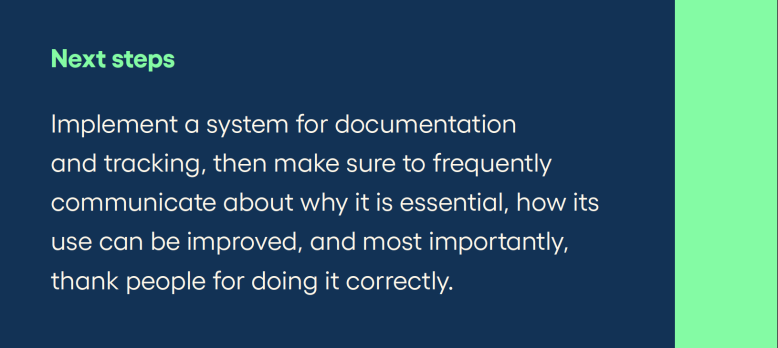
V. The time to adopt new technology is now
Organizations can no longer sleep on implementing technology at every level, including operations. From tracking to productivity, technology helps employers better understand inefficiencies within their company and assists in identifying opportunities for improvement.
An advantage of many modern software solutions is that they’re cloud-based and mobile. This means:
- → Teams can work anywhere in the field from a smart device, like a phone or tablet, as long as there is an internet or data connection.
- → Less time and money spent traveling to and from the office to collect work orders or record work performed.
- → Employees can see their tasks, complete work orders and include notes straight from the worksite.
So, what exactly is a CMMS? CMMS is a computerized maintenance management system designed to simplify and help oversee every detail of your assets and operations. This enables you to eliminate waste and avoid unnecessary costs. CMMS solutions are used across industries, but especially for facility and maintenance management.
There are many benefits of using CMMS, such as:
- → Time savings and increased productivity
- → More strategic capital planning and cost savings
- → Detailed reporting and data-driven business cases
- → Organized workflows and improved customer service
- → Decreased manual entry, errors and loss of information
Remember earlier when we talked about training? A CMMS can be easy to learn for all employees if you invest in training. Once it’s learned, the value can return tenfold through better documentation and increased efficiency, and even better data for future decision-making. If your employees regularly use a smartphone (and they likely do), they can quickly learn to navigate a CMMS. Before you know it, your organization can be connected and more productive.
The financial and time investment you make in utilizing technology to improve the way your organization works can realize a great return. For example, a CMMS can save maintenance teams as much as an hour per work order. So, if a team of six technicians averages a total of 5,000 work orders in a year — even if it’s just 15 minutes saved per work order — that’s 1,250 hours saved in a year.
If time is money, as they say, think of what you can save your organization by implementing a CMMS.
Technology can help modernize your operations. With the right software, historical data enables you to avoid repeating past mistakes and offers visibility into where and how you can improve. Plus, the information you collect through your software can help your team work more predictively, avoiding problems before they happen.
Tips to help your organization embrace new technology
Highlight benefits: Identify limitations or problems in the current process, and help your team understand the decision to bring technology on board.
- → Help them see how technology will solve these problems and make their jobs easier and allow them to be more productive.
- → Help your departments to see how getting involved earlier on means they get to be part of the solution and pave the way for future success.
Find champions: Your champions are managers and team members who welcome technology.
- → They can help encourage and train reluctant employees.
- → Some may not be convinced using technology is a positive change until they see other team members happily using and benefiting from it.
Provide ongoing training: Ensure team members of all technology comfort levels have the access they need to learn at their own speed and knowledge level.
- → Questions should be welcomed, and ongoing support should be provided until everyone is up and running.
- → Training should come from both external sources (the software manufacturer, for instance) and internal, such as your group of champions who are available to assist others.
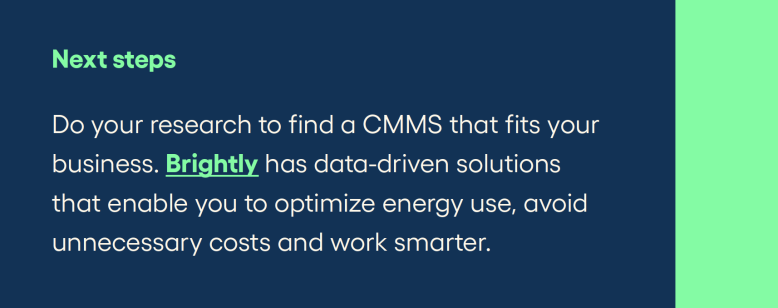
The bottom line
Business as usual has changed, especially when it comes to your employees. From challenges with the current labor market to leaning into digital transformation, now is a unique opportunity for organizations to rethink technology and processes to increase productivity, support an evolving workforce and help your business achieve sustainable growth in a time of uncertainty. There’s a responsibility for those in leadership positions to acknowledge the changing workforce and work with it, not against it to enable businesses to evolve.

The workforce is changing. It’s time you changed with it.
New and emerging trends are having a strong impact on both the consumer-facing and employee-facing sides of your business. Learn how to leverage technology to advance your enterprise strategy, create engaging employee experiences that support performance, retention and development, and build a workplace that positions your organization to sustain growth in an ever-changing business environment.
Brightly looks beyond the events of the day and into a future where every business is positioned to thrive. Download our ‘Navigating the Workforce’ eBook today to learn about the changes underway in your workforce, and how you can manage them.



